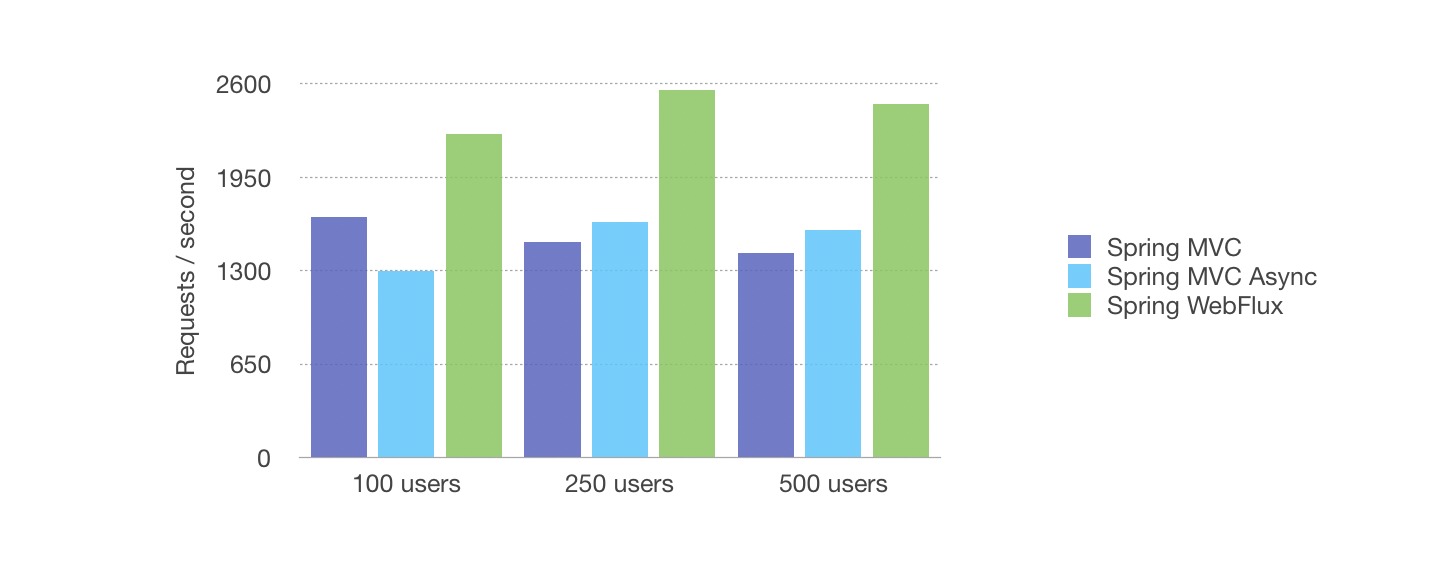Reactive vs Non-Reactive Spring Performance

Summary
The goal of this article is to compare the performance between Spring MVC (Non-Reactive) and Spring WebFlux (Reactive). For this task we have taken into account three differents implementations:
- Using Spring MVC synchronous
- Using Spring MVC asynchronous
- Using Spring WebFlux
Implementations
Using Spring MVC synchronous
For this implementation the next endpoints have been defined:
1
2
3
4
5
6
7
8
9
@RequestMapping("/mvcsync/{id}")
public Message findById(@PathVariable(value = "id") String id) {
return nonReactiveRepository.findById(id).orElse(null);
}
@PostMapping("/mvcsync")
public Message post(@Valid @RequestBody Message message) {
return nonReactiveRepository.save(message);
}
Using Spring MVC asynchronous
Java 8 CompletableFuture library has been used to get asynchronous methods.
1
2
3
4
5
6
7
8
9
@RequestMapping("/mvcasync/{id}")
public CompletableFuture<Message> findById(@PathVariable(value = "id") String id) {
return CompletableFuture.supplyAsync(() -> nonReactiveRepository.findById(id).orElse(null));
}
@PostMapping("/mvcasync")
public CompletableFuture<Message> post(@Valid @RequestBody Message message) {
return CompletableFuture.supplyAsync(() -> nonReactiveRepository.save(message));
}
Using Spring WebFlux
The reactive version including MongoDB Reactive Repository.
1
2
3
4
5
6
7
8
9
@RequestMapping("/reactive/{id}")
public Mono<Message> findByIdReactive(@PathVariable(value = "id") String id) {
return reactiveRepository.findById(id);
}
@PostMapping("/reactive")
public Mono<Message> postReactive(@Valid @RequestBody Message message) {
return reactiveRepository.save(message);
}
The Test
Using JMeter we have created a test with the next characteristics:
- Each iteration will be composed by one create operation (POST) and one find operation (GET) to MongoDB.
- For each test, we are defining the number of concurrent users/threads
Hardware:
- MacBook Pro (15-inch, 2016)
- 2,6 GHz Intel Core i7
- 16 GB 2133 MHz LPDDR3
Results
The results shown in the following table refer to a one-minute execution with a one-second ramp-up period.

Now, we can extract the following conclusions based in our tests:
- Spring MVC Sync vs Async are similar in performance but with the asynchronous implementation we have a less error rate at beginning of the execution
- Spring WebFlux allows an increment in performance greater than 60% respect to Spring MVC
References
[1] Link to the project in Github
 Never miss a story from us, subscribe to our newsletter
Never miss a story from us, subscribe to our newsletter